Comprehensive Utilization of Industry By-Products in Precast Concrete: A Critical Review from the Perspective of Physicochemical Characteristics of Solid Waste and Steam Curing Conditions
Abstract
:1. Introduction
2. Steaming System
2.1. The Process of Steam Curing
2.2. Steam Curing Parameters
2.2.1. Precuring Time
2.2.2. Temperature Rise/Cooling Rates
2.2.3. Temperature during Steam Curing
2.2.4. Time of Steam Curing
2.3. Problems in the Steam Curing System
3. Application of Solid Wastes in Precast Concrete
3.1. Deformation
3.2. Pore Structure
3.3. Cl− Permeability
3.4. Delayed Ettringite Formation
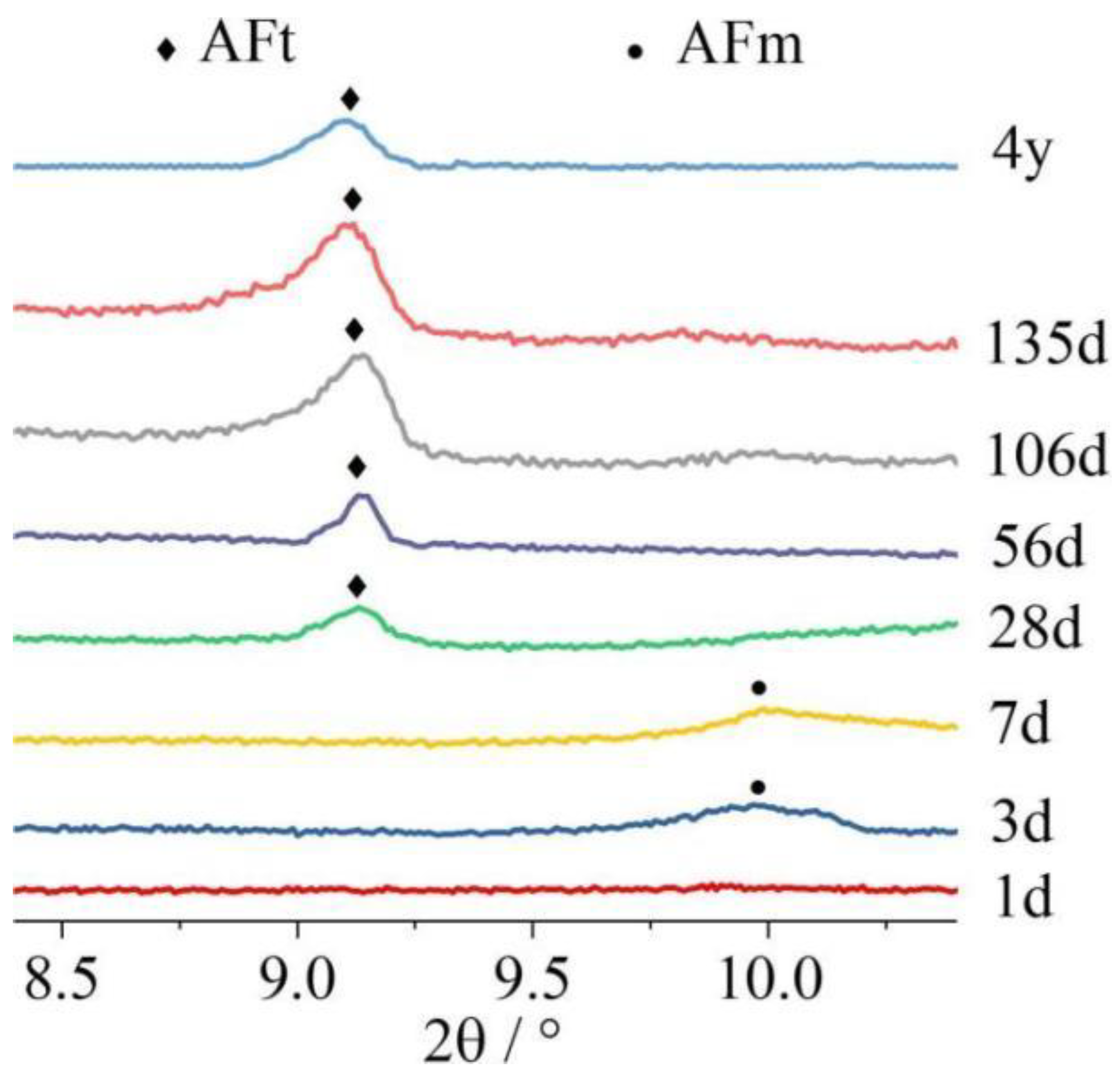
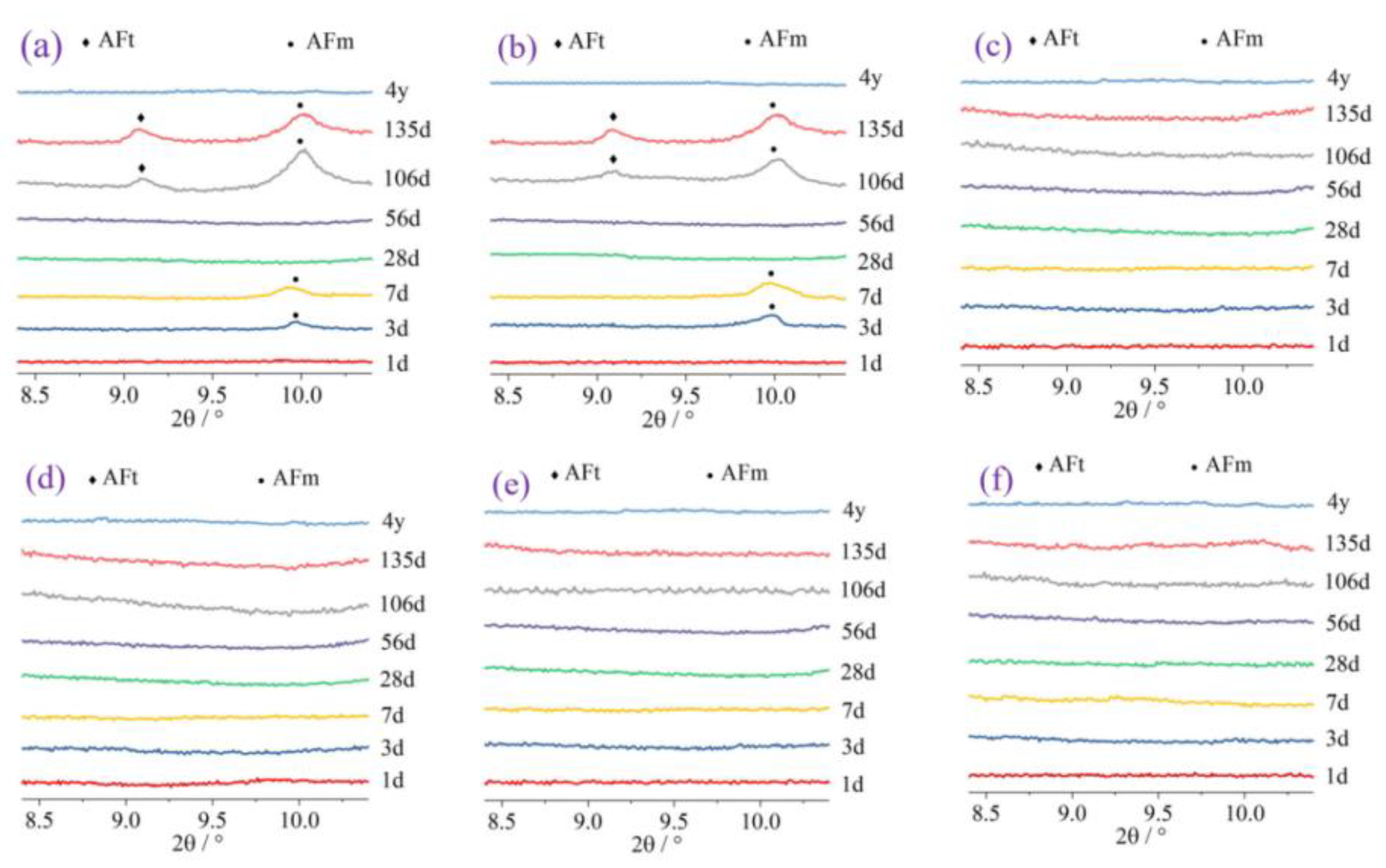
3.5. Compressive Strength
3.6. Common Solid Wastes
3.6.1. High-Calcium Solid Wastes
3.6.2. Low-Calcium Solid Wastes
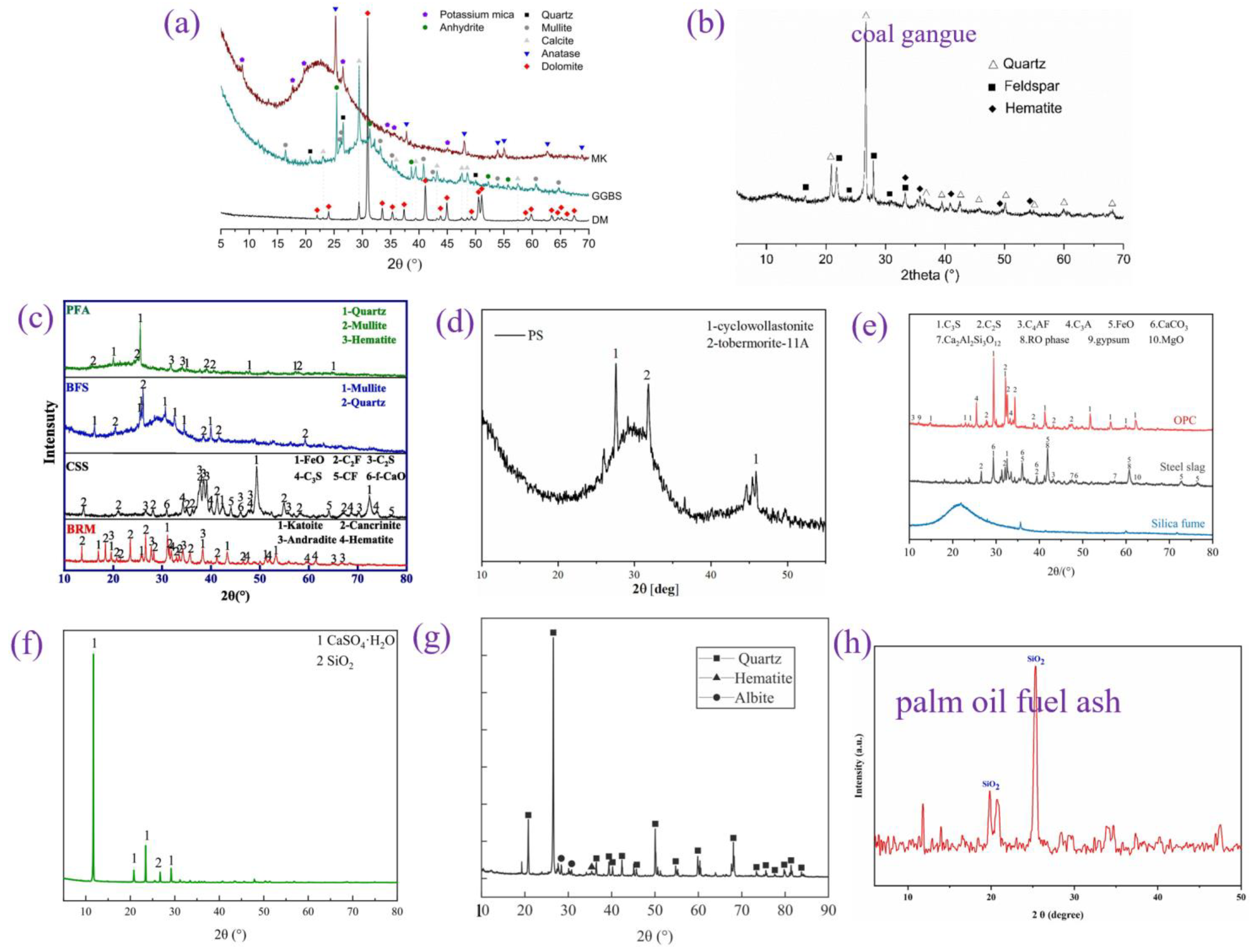
| Project | SO3/Al2O3 Ratio | Mechanism of Action | Recommendation Method of Incorporation | Recommendation Dosage/% | Reference |
|---|---|---|---|---|---|
| GGBS | 0.131–0.309 | Microaggregate effect, pozzolanic reaction, dilution effect. | Can be mixed separately. | 30–40 | [39,43,58] |
| POFA | 0.021–0.058 | 30–40 | [48,77,84] | ||
| CG | 0.018–0.022 | Microaggregate effect, dilution effect. | 20–30 | [49,56] | |
| FA | 0.011–0.059 | 20–30 | [37,39,46] | ||
| Iron tailing powder | 0.045–0.094 | 10–20 | [57,85] | ||
| Phosphorus slag | 0.283–0.780 | 10–15 | [17,86,87] | ||
| Phosphogypsum | 51.4–77.16 | Microaggregate effect, dilution effect, synergistic effects with highly active supplementary cementitious materials such as silica fume. | Mixed with other supplementary cementitious materials. | 5–10 | [82,88] |
| Steel slag | 0.080–0.197 | 10–15 | [81,89] | ||
| RM | 0.027–0.033 | Red mud can stimulate the activity of silica-alumina in cement through its high alkalinity, which can promote the development of early strength in precast concrete. | 10–20 | [42,90,91] |
3.7. Mechanisms of Solid Wastes as a Cement Substitute
4. Synergy between Solid Wastes at High Temperatures
5. Conclusions
- (1)
- Early temperature and humidity field changes determine the evolution of precast concrete properties. Although high temperatures can accelerate the early hydration rate of cementitious materials, they also jeopardize the late strength and durability of precast concrete. Therefore, a reasonable steam curing system needs to be selected according to the actual situation.
- (2)
- Solid waste as a cement substitute can improve the properties of precast concrete by maintaining volumetric stability, optimizing pore structure, increasing late strength and reducing Cl− permeability. In addition, it can also reduce carbon emissions, save resources and protect the environment.
- (3)
- The use of solid waste leads to a reduction in the demolding strength. When 30% of the cement was replaced with low-activity solid waste, the demolding strength decreased by 20%. When the substitution rate is less than 15%, the synergistic mechanism between the high-activity gelling material and the low-activity solid waste can increase the demolding strength, whereas a decrease in the total cementitious content is detrimental to demolding when the substitution rate is above 25%. The intense pozzolanic reaction between Ca(OH)2 and high-activity solid waste can boost the development of early strength, so incorporating 40% high-activity solid waste will only slightly reduce the strength.
- (4)
- Solid waste can improve the late strength of precast concrete. Low-activity solid wastes contain little active cementitious material and are subject to a combination of steam curing conditions, water–cement ratios and admixtures when used as a cement substitute. At a total substitution rate of approximately 20% for low-activity solid wastes and high-activity cementitious materials, the late strength increased by 10%. At a substitution rate of less than 40%, a synergistic effect between the cementitious materials was still present, which contributed to the development of the late strength. When the high-activity solid waste dose is less than 60%, the sustained pozzolanic reaction results in a significant increase in the late strength.
- (5)
- The synergistic effect between multiple solid wastes under room temperature conditions has been a hot research issue in the field of building materials. After the preliminary research, it was found that the synergistic effect between alkaline-sulfate-aluminosilicate solid waste remains under high temperature steam curing conditions. In order to reduce environmental pollution and to dissipate stockpiled solid waste, it is necessary to thoroughly study the synergistic mechanism of multiple solid wastes under high-temperature steam curing conditions as well as the regulatory mechanism.
- (6)
- Synergistic effects between solid wastes are the key to maximizing the utilization of solid wastes under steam curing conditions, and synergistic effects between high doses of solid wastes should be controlled according to the chemical composition of the solid wastes.
Author Contributions
Funding
Institutional Review Board Statement
Informed Consent Statement
Data Availability Statement
Conflicts of Interest
References
- Elnaggar, M.A.; Omar, M.S.; Yassin, A.M. Rehabilitation of defective connections between two precast concrete segments (experimental and analytical study). Constr. Build. Mater. 2023, 368, 130498. [Google Scholar] [CrossRef]
- Xu, Y.; Chen, Y.; Chen, Q.; Chu, H.; Zu, H.; Jiang, S.; Jiang, P.; Mao, J. Influence of curing system on static and dynamic mechanical properties of fly ash concrete. Constr. Build. Mater. 2023, 371, 130714. [Google Scholar] [CrossRef]
- Weng, Y.; Li, M.; Ruan, S.; Wong, T.N.; Tan, M.J.; Yeong, K.L.O.; Qian, S. Comparative economic, environmental and productivity assessment of a concrete bathroom unit fabricated through 3D printing and a precast approach. J. Clean. Prod. 2020, 261, 121245. [Google Scholar] [CrossRef]
- Ghayeb, H.H.; Razak, H.A.; Sulong, N.R. Evaluation of the CO2 emissions of an innovative composite precast concrete structure building frame. J. Clean. Prod. 2020, 242, 118567. [Google Scholar] [CrossRef]
- Yu, J.; Xia, Y.; Guo, Z.; Guo, X. Experimental study on the structural behavior of exterior precast concrete beam-column joints with high-strength steel bars in field-cast RPC. Eng. Struct. 2024, 299, 117128. [Google Scholar] [CrossRef]
- Ge, L.; Zhang, Y.; Sayed, U.; Li, H. Study on properties of basalt fiber reinforcing reactive powder concrete under different curing conditions. J. Mater. Res. Technol. 2023, 27, 5739–5751. [Google Scholar] [CrossRef]
- Esmaeili, K.; Ghahari, S.; Ramezanianpour, A. Influence of initial steam curing and different types of mineral additives on mechanical and durability properties of self-compacting concrete. Constr. Build. Mater. 2014, 73, 187–194. [Google Scholar] [CrossRef]
- Cassagnabère, F.; Escadeillas, G.; Mouret, M. Study of the reactivity of cement/metakaolin binders at early age for specific use in steam cured precast concrete. Constr. Build. Mater. 2009, 23, 775–784. [Google Scholar] [CrossRef]
- Cui, K.; Lu, D.; Jiang, T.; Zhang, J.; Jiang, Z.; Zhang, G.; Chang, J.; Lau, D. Understanding the role of carbon nanotubes in low carbon sulfoaluminate cement-based composite. J. Clean. Prod. 2023, 416, 137843. [Google Scholar] [CrossRef]
- Teune, I.; Schollbach, K. Triethanolamine-promoted separation of calcium from recycled concrete fines during aqueous carbonation. Resour. Conserv. Recycl. 2024, 206, 107604. [Google Scholar] [CrossRef]
- Bingöl, A.F.; Tohumcu, I. Effects of different curing regimes on the compressive strength properties of self compacting concrete incorporating fly ash and silica fume. Mater. Des. 2013, 51, 12–18. [Google Scholar] [CrossRef]
- Zhang, J.; Ye, C.; Tan, H.; Liu, X. Potential application of Portland cement-sulfoaluminate cement system in precast concrete cured under ambient temperature. Constr. Build. Mater. 2020, 251, 118869. [Google Scholar] [CrossRef]
- Yang, L.; Huang, Q.; Che, Q.; Gao, D.; Cheng, S. Effect of long-term drying on the performance of sulfoaluminate cement. J. Mater. Res. Technol. 2023, 27, 4664–4672. [Google Scholar] [CrossRef]
- Han, F.; An, S.-Y.; Liu, L.; Wang, Y.; Ma, L.-Q.; Yang, L. Early-age shrinkage behavior of cement-fly ash paste under wind speeds: A study using BSE-IA and MIP techniques. Chemosphere 2023, 332, 138891. [Google Scholar] [CrossRef]
- Tao, Y.; Rahul, A.; Mohan, M.K.; De Schutter, G.; Van Tittelboom, K. Recent progress and technical challenges in using calcium sulfoaluminate (CSA) cement. Cem. Concr. Compos. 2023, 137, 104908. [Google Scholar] [CrossRef]
- Wang, J.; Kong, X.; Yin, J. Formation of synthetic C-S-H in the presence of triethanolamine and/or polycarboxylate polymers. Constr. Build. Mater. 2024, 424, 135881. [Google Scholar] [CrossRef]
- Zhang, L.; Lu, Z.; Zhang, Y.; Liu, Z.; Pan, Y.; Zhang, G.; He, Y.; Sun, Z. New insight into the combined effect of aluminum sulfate and triethanolamine on cement hydration. Cem. Concr. Res. 2024, 181, 107547. [Google Scholar] [CrossRef]
- Qadri, F.; Kumar, S.R.; Garg, N. Impact of C–S–H seeds on cementitious hydration kinetics: New insights on porosity and microstructure. Mater. Today Commun. 2024, 38, 107763. [Google Scholar] [CrossRef]
- Hu, S.; Xu, Z.; Ma, X.; Huo, Y.; Yang, Y. Preparation of C-S-H seeds from solid waste and its application as Portland cement accelerator. Constr. Build. Mater. 2024, 428, 136277. [Google Scholar] [CrossRef]
- Feng, X.; Zhuo, C.; Yin, S. The application of C–S–H accelerators in the precast concrete industry: Early-age properties and CO2 footprint analysis. J. Clean. Prod. 2024, 435, 140558. [Google Scholar] [CrossRef]
- Zhang, M.; Yang, L.; Wang, F. Understanding the longer-term effects of C–S–H seeding materials on the performance of limestone calcined clay cement. Constr. Build. Mater. 2023, 392, 131829. [Google Scholar] [CrossRef]
- Huang, X.; Hu, S.; Wang, F.; Yang, L.; Rao, M.; Mu, Y.; Wang, C. The effect of supplementary cementitious materials on the per-meability of chloride in steam cured high-ferrite Portland cement concrete. Constr. Build. Mater. 2019, 197, 99–106. [Google Scholar] [CrossRef]
- Wang, M.; Xie, Y.; Long, G.; Ma, C.; Zeng, X.; Qiang, F. The impact mechanical characteristics of steam-cured concrete under different curing temperature conditions. Constr. Build. Mater. 2020, 241, 118042. [Google Scholar] [CrossRef]
- Shen, P.; Lu, L.; Chen, W.; Wang, F.; Hu, S. Efficiency of metakaolin in steam cured high strength concrete. Constr. Build. Mater. 2017, 152, 357–366. [Google Scholar] [CrossRef]
- Jiang, W.; Wu, L. Flow shop optimization of hybrid make-to-order and make-to-stock in precast concrete component production. J. Clean. Prod. 2021, 297, 126708. [Google Scholar] [CrossRef]
- Juan-Valdés, A.; Rodríguez-Robles, D.; García-González, J.; Guerra-Romero, M.I.; Morán-del Pozo, J.M. Mechanical and microstructural characterization of non-structural precast concrete made with recycled mixed ceramic aggregates from construction and demolition wastes. J. Clean. Prod. 2018, 180, 482–493. [Google Scholar] [CrossRef]
- Zhao, B.; Wang, G.; Wu, B.; Kong, X. A study on mechanical properties and permeability of steam-cured mortar with iron-copper tailings. Constr. Build. Mater. 2023, 383, 131372. [Google Scholar] [CrossRef]
- Chen, G.; Huang, Y.; Yang, R.; Yu, R.; Xiao, R.; Wang, Z.; Ke, X.; Xie, G.; Cheng, J.; Bao, M. Comparative study on mechanical properties and microstructure development of ultra-high performance concrete incorporating phosphorous slag under different curing regimes. Constr. Build. Mater. 2023, 392, 131963. [Google Scholar] [CrossRef]
- Salesa, Á.; Pérez-Benedicto, J.A.; Colorado-Aranguren, D.; López-Julián, P.L.; Esteban, L.M.; Sanz-Baldúz, L.J.; Sáez-Hostaled, J.L.; Ramis, J.; Olivares, D. Physico—Mechanical properties of multi—Recycled concrete from precast concrete industry. J. Clean. Prod. 2017, 141, 248–255. [Google Scholar] [CrossRef]
- Kim, T.; Kim, Y.-W.; Lee, D.; Kim, M. Reinforcement learning approach to scheduling of precast concrete production. J. Clean. Prod. 2022, 336, 130419. [Google Scholar] [CrossRef]
- Long, G.; Yang, J.; Xie, Y. The mechanical characteristics of steam-cured high strength concrete incorporating with lightweight aggregate. Constr. Build. Mater. 2017, 136, 456–464. [Google Scholar] [CrossRef]
- Iv, G.M.; Dalesandro, K.; Young, M.; Soliman, M. Waste-to-Energy reclaimed sands as lightweight aggregates for internally cured self-consolidated precast concrete. Constr. Build. Mater. 2021, 280, 122545. [Google Scholar] [CrossRef]
- Wong, R.W.; Loo, B.P. Sustainability implications of using precast concrete in construction: An in-depth project-level analysis spanning two decades. J. Clean. Prod. 2022, 378, 134486. [Google Scholar] [CrossRef]
- Lu, J.-X.; Zheng, H.; Yang, S.; He, P.; Poon, C.S. Co-utilization of waste glass cullet and glass powder in precast concrete products. Constr. Build. Mater. 2019, 223, 210–220. [Google Scholar] [CrossRef]
- He, J.-X.; Xu, Z.-D.; Zhang, L.-Y.; Lin, Z.-H.; Hu, Z.-W.; Li, Q.-Q.; Dong, Y.-R. Shaking table tests and seismic assessment of a full-scale precast concrete sandwich wall panel structure with bolt connections. Eng. Struct. 2023, 278, 115543. [Google Scholar] [CrossRef]
- Shi, J.; Liu, B.; Zhou, F.; Shen, S.; Dai, J.; Ji, R.; Tan, J. Heat damage of concrete surfaces under steam curing and improvement measures. Constr. Build. Mater. 2020, 252, 119104. [Google Scholar] [CrossRef]
- Wang, P.; Li, X.; Huo, X.; Ali, S.; Sun, J.; Qin, J.; Liang, K.; Liu, Y. Early hydration and compressive strength of steam cured high-strength concrete based on simplex centroid design method. Case Stud. Constr. Mater. 2022, 17, e01583. [Google Scholar] [CrossRef]
- Yang, J.; Hu, H.; He, X.; Su, Y.; Wang, Y.; Tan, H.; Pan, H. Effect of steam curing on compressive strength and microstructure of high volume ultrafine fly ash cement mortar. Constr. Build. Mater. 2021, 266, 120894. [Google Scholar] [CrossRef]
- Yu, Y.; Jin, Z.; Shao, S.; Zhang, X.; Li, N.; Xiong, C. Evolution of temperature stress and tensile properties of concrete during steam-curing process. Constr. Build. Mater. 2021, 305, 124691. [Google Scholar] [CrossRef]
- Shi, J.; Liu, B.; Wu, X.; Tan, J.; Dai, J.; Ji, R. Effect of steam curing on surface permeability of concrete: Multiple transmission media. J. Build. Eng. 2020, 32, 101475. [Google Scholar] [CrossRef]
- Shi, J.; Liu, B.; Wu, X.; Qin, J.; Jiang, J.; He, Z. Evolution of mechanical properties and permeability of concrete during steam curing process. J. Build. Eng. 2020, 32, 101796. [Google Scholar] [CrossRef]
- Shao, Y.; Ma, S.; Li, S.; Chen, D.; Zhang, Z.; Ren, Q. Low carbon research in precast concrete based on the synergistic mechanism of red mud-ground granulated blast furnace slag powder. J. Clean. Prod. 2024, 439, 140882. [Google Scholar] [CrossRef]
- Shiyu, Z.; Qiang, W.; Yuqi, Z. Research on the resistance to saline soil erosion of high-volume mineral admixture steam-cured concrete. Constr. Build. Mater. 2019, 202, 1–10. [Google Scholar] [CrossRef]
- Shi, J.; Liu, B.; Zhou, F.; Shen, S.; Guo, A.; Xie, Y. Effect of steam curing regimes on temperature and humidity gradient, permeability and microstructure of concrete. Constr. Build. Mater. 2021, 281, 122562. [Google Scholar] [CrossRef]
- Zou, C.; Long, G.; Ma, C.; Xie, Y. Effect of subsequent curing on surface permeability and compressive strength of steam-cured concrete. Constr. Build. Mater. 2018, 188, 424–432. [Google Scholar] [CrossRef]
- Ogawa, Y.; Bui, P.T.; Kawai, K.; Sato, R. Effects of porous ceramic roof tile waste aggregate on strength development and carbonation resistance of steam-cured fly ash concrete. Constr. Build. Mater. 2020, 236, 117462. [Google Scholar] [CrossRef]
- Zeyad, A.M.; Johari, M.A.M.; Abutaleb, A.; Tayeh, B.A. The effect of steam curing regimes on the chloride resistance and pore size of high–strength green concrete. Constr. Build. Mater. 2021, 280, 122409. [Google Scholar] [CrossRef]
- Zeyad, A.M.; Johari, M.A.M.; Abadel, A.; Abutaleb, A.; Mijarsh, M.; Almalki, A. Transport properties of palm oil fuel ash-based high-performance green concrete subjected to steam curing regimes. Case Stud. Constr. Mater. 2022, 16, e01077. [Google Scholar] [CrossRef]
- Zhang, J.; Chen, T.; Gao, X. Incorporation of self-ignited coal gangue in steam cured precast concrete. J. Clean. Prod. 2021, 292, 126004. [Google Scholar] [CrossRef]
- Lou, B.; Ma, F. Evolution on fracture properties of concrete during steam curing. Case Stud. Constr. Mater. 2022, 16, e01105. [Google Scholar] [CrossRef]
- Yan, X.; Jiang, L.; Guo, M.; Chen, Y.; Song, Z.; Bian, R. Evaluation of sulfate resistance of slag contained concrete under steam curing. Constr. Build. Mater. 2019, 195, 231–237. [Google Scholar] [CrossRef]
- Liu, B.; Shi, J.; Zhou, F.; Shen, S.; Ding, Y.; Qin, J. Effects of steam curing regimes on the capillary water absorption of concrete: Prediction using multivariable regression models. Constr. Build. Mater. 2020, 256, 119426. [Google Scholar] [CrossRef]
- Tran, V.M.; Nguyen, L.T.; Nguyen, T.H.Y. Enhancing the effectiveness of steam curing for cement paste incorporating fly ash based on long-term compressive strength and reaction degree of fly ash. Case Stud. Constr. Mater. 2022, 16, e01146. [Google Scholar] [CrossRef]
- Ba, M.-F.; Qian, C.-X.; Guo, X.-J.; Han, X.-Y. Effects of steam curing on strength and porous structure of concrete with low water/binder ratio. Constr. Build. Mater. 2011, 25, 123–128. [Google Scholar] [CrossRef]
- Wang, P.; Fu, H.; Guo, T.; Zuo, W.; Zhao, H.; Tian, L.; Chen, C. Volume deformation of steam-cured concrete with fly ash during and after steam curing. Constr. Build. Mater. 2021, 306, 124854. [Google Scholar] [CrossRef]
- Yao, B.; Ren, G.; Huang, J.; Gao, X. Influence of self-ignition coal gangue on properties of foam concrete with steam curing. Case Stud. Constr. Mater. 2022, 17, e01316. [Google Scholar] [CrossRef]
- Han, F.; Song, S.; Liu, J.; Huang, S. Properties of steam-cured precast concrete containing iron tailing powder. Powder Technol. 2019, 345, 292–299. [Google Scholar] [CrossRef]
- Chen, B.; Chen, J.; Chen, X.; Qiang, S.; Zheng, Y. Experimental study on compressive strength and frost resistance of steam cured concrete with mineral admixtures. Constr. Build. Mater. 2022, 325, 126725. [Google Scholar] [CrossRef]
- Xu, X.; Jin, Z.; Yu, Y.; Li, N. Impact properties of Ultra High Performance Concrete (UHPC) cured by steam curing and standard curing. Case Stud. Constr. Mater. 2022, 17, e01321. [Google Scholar] [CrossRef]
- Lv, P.; Long, G.; Xie, Y.; Peng, J.; Guo, S. Study on the mitigation of drying shrinkage and crack of limestone powder cement paste and its mechanism. Constr. Build. Mater. 2024, 411, 134325. [Google Scholar] [CrossRef]
- Li, X.; Liu, Z.; Lv, Y.; Cai, L.; Jiang, D.; Jiang, W.; Jian, S. Utilization of municipal solid waste incineration bottom ash in autoclaved aerated concrete. Constr. Build. Mater. 2018, 178, 175–182. [Google Scholar] [CrossRef]
- Zhuang, S.; Sun, J. The feasibility of properly raising temperature for preparing high-volume fly ash or slag steam-cured concrete: An evaluation on DEF, 4-year strength and durability. Constr. Build. Mater. 2020, 242, 118094. [Google Scholar] [CrossRef]
- Xu, Y.; Yuan, Q.; De Schutter, G.; Xiang, G.; Hu, C.; Chen, L. Mechanism of concrete damage under the coupled action of freeze-thaw cycle and low-stress impact fatigue load: From pore structure to energy dissipation. Constr. Build. Mater. 2024, 436, 136980. [Google Scholar] [CrossRef]
- Jiang, Z.; Hong, S.; Fu, C.; Li, Q.; Tang, K.; Yan, W. Effect of NaCl solution wet-dry cycles on pore structure and oxygen diffusivity of axial tensile fatigue damaged concrete. J. Build. Eng. 2024, 86, 108881. [Google Scholar] [CrossRef]
- Deng, G.; He, Y.; Lu, L.; Wang, F.; Hu, S. Pore structure evolution and sulfate attack of high-volume slag blended mortars under standard curing and steam curing. Constr. Build. Mater. 2023, 363, 129878. [Google Scholar] [CrossRef]
- Zhang, Z.; Wang, Q.; Chen, H. Properties of high-volume limestone powder concrete under standard curing and steam-curing conditions. Powder Technol. 2016, 301, 16–25. [Google Scholar] [CrossRef]
- Song, W.; Guo, T.; Wang, X.; Wang, X.; Wang, R.; Han, P. Chloride ion permeation and electrochemical impedance response of red mud-coal metakaolin geopolymer concrete. Int. J. Electrochem. Sci. 2024, 19, 100436. [Google Scholar] [CrossRef]
- Shi, W.; Liu, Y.; Wang, W.; Duan, P.; Wang, Z.; Shang, Z. Relationship between chloride ion permeation resistance of recycled aggregate thermal insulation concrete and pore structure parameters. Constr. Build. Mater. 2023, 370, 130666. [Google Scholar] [CrossRef]
- Chen, P.; Ma, B.; Tan, H.; Liu, X.; Zhang, T.; Li, C.; Yang, Q.; Luo, Z. Utilization of barium slag to improve chloride-binding ability of cement-based material. J. Clean. Prod. 2021, 283, 124612. [Google Scholar] [CrossRef]
- Panesar, D.; Aqel, M.; Rhead, D.; Schell, H. Effect of cement type and limestone particle size on the durability of steam cured self-consolidating concrete. Cem. Concr. Compos. 2017, 80, 175–189. [Google Scholar] [CrossRef]
- Ramu, Y.K.; Sirivivatnanon, V.; Thomas, P.; Dhandapani, Y.; Vessalas, K. Evaluating the impact of curing temperature in delayed ettringite formation using electrochemical impedance spectroscopy. Constr. Build. Mater. 2021, 282, 122726. [Google Scholar] [CrossRef]
- Wang, C.; Jin, Z.; Pang, B.; Li, J.; Dong, W.; Chen, R. Experimental study of delayed ettringite formation under geothermal high-temperature environment. J. Build. Eng. 2023, 78, 107519. [Google Scholar] [CrossRef]
- Paul, A.; Rashidi, M.; Kim, J.-Y.; Jacobs, L.J.; Kurtis, K.E. The impact of sulfate- and sulfide-bearing sand on delayed ettringite formation. Cem. Concr. Compos. 2022, 125, 104323. [Google Scholar] [CrossRef]
- Pichelin, A.; Carcassès, M.; Cassagnabère, F.; Multon, S.; Nahas, G. Sustainability, transfer and containment properties of concrete subject to delayed ettringite formation (DEF). Cem. Concr. Compos. 2020, 113, 103738. [Google Scholar] [CrossRef]
- Zhang, R.; He, H.; Song, Y.; Zhi, X.; Fan, F. Influence of mix proportioning parameters and curing regimes on the properties of ultra-high strength alkali-activated concrete. Constr. Build. Mater. 2023, 393, 132139. [Google Scholar] [CrossRef]
- Gonzalez-Corominas, A.; Etxeberria, M.; Poon, C.S. Influence of steam curing on the pore structures and mechanical properties of fly-ash high performance concrete prepared with recycled aggregates. Cem. Concr. Compos. 2016, 71, 77–84. [Google Scholar] [CrossRef]
- Zeyad, A.M.; Johari, M.A.M.; Alharbi, Y.R.; Abadel, A.A.; Amran, Y.M.; Tayeh, B.A.; Abutaleb, A. Influence of steam curing regimes on the properties of ultrafine POFA-based high-strength green concrete. J. Build. Eng. 2021, 38, 102204. [Google Scholar] [CrossRef]
- Vaasudevaa, B.; Dhandapani, Y.; Santhanam, M. Performance evaluation of limestone-calcined clay (LC2) combination as a cement substitute in concrete systems subjected to short-term heat curing. Constr. Build. Mater. 2021, 302, 124121. [Google Scholar] [CrossRef]
- Zhang, W.; Hao, X.; Wei, C.; Zeng, Q.; Ma, S.; Liu, X.; Zhang, Z.; Webeck, E. Synergistic enhancement of converter steelmaking slag, blast furnace slag, Bayer red mud in cementitious materials: Strength, phase composition, and microstructure. J. Build. Eng. 2022, 60, 105177. [Google Scholar] [CrossRef]
- Su, Y.; Zhao, H.; He, X.; Zheng, Z.; Ma, Q.; Ding, J.; Bao, M. The effect of wet-grinding phosphorus slag on the hydration kinetics of Portland cement. Constr. Build. Mater. 2023, 364, 129942. [Google Scholar] [CrossRef]
- Fan, D.; Zhang, C.; Lu, J.-X.; Liu, K.; Yin, T.; Dong, E.; Yu, R. Recycling of steel slag powder in green ultra-high strength concrete (UHSC) mortar at various curing conditions. J. Build. Eng. 2023, 70, 106361. [Google Scholar] [CrossRef]
- Zhao, B.; Wang, G.; Zhao, K.; Wang, M.; Wu, B.; Li, S.; Chen, Q.; Geng, J. Mechanical properties, permeability and microstructure of steam-cured fly ash mortar mixed with phosphogypsum. Constr. Build. Mater. 2023, 400, 132582. [Google Scholar] [CrossRef]
- Shi, J.; Pan, W.; Kang, J.; Yu, Z.; Sun, G.; Li, J.; Zheng, K.; Shen, J. Properties of Ultra-High Performance Concrete incorporating iron tailings powder and iron tailings sand. J. Build. Eng. 2024, 83, 108442. [Google Scholar] [CrossRef]
- Huseien, G.F.; Khamehchi, M.; Kubba, Z.; Benjeddou, O.; Mahmoodi, M.J. Freeze-thaw cycle and abrasion resistance of alkali-activated FA and POFA-based mortars: Role of high volume GBFS incorporation. Heliyon 2023, 9, e17672. [Google Scholar] [CrossRef]
- Wei, Y.; Lei, X.-F.; Luo, S.-H.; Sun, K.; Chen, H.-H.; Mu, W.-N.; Teng, F.; Yan, S. Effect of pore-forming agent on degradation of phenol by iron tailings based porous ceramics. Ceram. Int. 2024, 50, 33791–33801. [Google Scholar] [CrossRef]
- Liu, Z.; Yu, Q.; Ma, W.; Liu, J.; Tao, S. Experimental investigation on centrifugal granulation of molten yellow phosphorus slag. Chem. Eng. Res. Des. 2023, 197, 548–557. [Google Scholar] [CrossRef]
- Cui, S.; Fan, K.; Yao, Y. Preparation and characterization of quaternary clinker-free cementitious materials containing phosphorus slag, calcium carbide slag, desulfurization gypsum, and metakaolin. Constr. Build. Mater. 2024, 411, 134602. [Google Scholar] [CrossRef]
- Bao, H.; Zheng, Z.; Xu, G.; Li, R.; Wang, Q.; Saafi, M.; Ye, J. Performance and mechanism of sand stabilization via microbial-induced CaCO3 precipitation using phosphogypsum. J. Clean. Prod. 2024, 468, 142999. [Google Scholar] [CrossRef]
- Xu, F.; Meng, H.; Liu, W.; Tang, X.; Ma, W. Effect of steel slag as alkaline exciter on the properties of supersulfated cement. Mater. Lett. 2024, 369, 136631. [Google Scholar] [CrossRef]
- Zhang, Z.; Song, Z.; Ke, G.; Dong, X. Strengthening mechanism of red mud with calcium oxide. Constr. Build. Mater. 2024, 424, 135932. [Google Scholar] [CrossRef]
- Li, G.; Gao, D.; Yi, L.; Luo, J.; Liu, J.; Jiang, T. Value-added recycling of iron and titanium from bauxite residue (Red Mud) via a flux-free smelting separation process. Sep. Purif. Technol. 2024, 346, 127495. [Google Scholar] [CrossRef]
- Kaplan, G.; Bayraktar, O.Y.; Bayrak, B.; Celebi, O.; Bodur, B.; Oz, A.; Aydin, A.C. Physico-mechanical, thermal insulation and resistance characteristics of diatomite and attapulgite based geopolymer foam concrete: Effect of different curing regimes. Constr. Build. Mater. 2023, 373, 130850. [Google Scholar] [CrossRef]
- Xie, Y.; Wang, X.; Long, G.; Ma, C. Quantitative analysis of the influence of subfreezing temperature on the mechanical properties of steam-cured concrete. Constr. Build. Mater. 2019, 206, 504–511. [Google Scholar] [CrossRef]
- Mo, Z.; Han, Y.; Jiang, L.; Wang, J.; Gao, X. Strength properties and hydration of ultra-high performance concrete incorporating calcined clay and limestone with steam curing regimes. Case Stud. Constr. Mater. 2022, 17, e01658. [Google Scholar] [CrossRef]
- Wei, C.; Yan, Y.; Zhang, Z.; Liu, X.; Wu, P.; Gu, J.; Han, F.; Ren, Q. Insight into the synergic effects of circulating fluidized bed fly ash, red mud and blast furnace slag in preparation of ultrahigh-performance concrete: Reaction mechanism and performance optimization. Constr. Build. Mater. 2023, 403, 133120. [Google Scholar] [CrossRef]
- Wu, P.; Zeng, Q.; Liu, X.; Zhang, Z.; Wei, C.; Li, Y.; Ma, S. Synergistic preparation of high-performance composite blast furnace slag powder from multiple industrial solid wastes: Performance regulation and optimization. Constr. Build. Mater. 2024, 411, 134231. [Google Scholar] [CrossRef]
- Wang, H.; Wang, Y.; Liu, X.; Zhang, Z. Leaching kinetics and reactivity evaluation of fly ash based on the synergistic effect of alkali and sulfate. J. Build. Eng. 2023, 80, 108041. [Google Scholar] [CrossRef]
- Liu, X.; Zhao, X.; Yin, H.; Chen, J.; Zhang, N. Intermediate-calcium based cementitious materials prepared by MSWI fly ash and other solid wastes: Hydration characteristics and heavy metals solidification behavior. J. Hazard. Mater. 2018, 349, 262–271. [Google Scholar] [CrossRef]

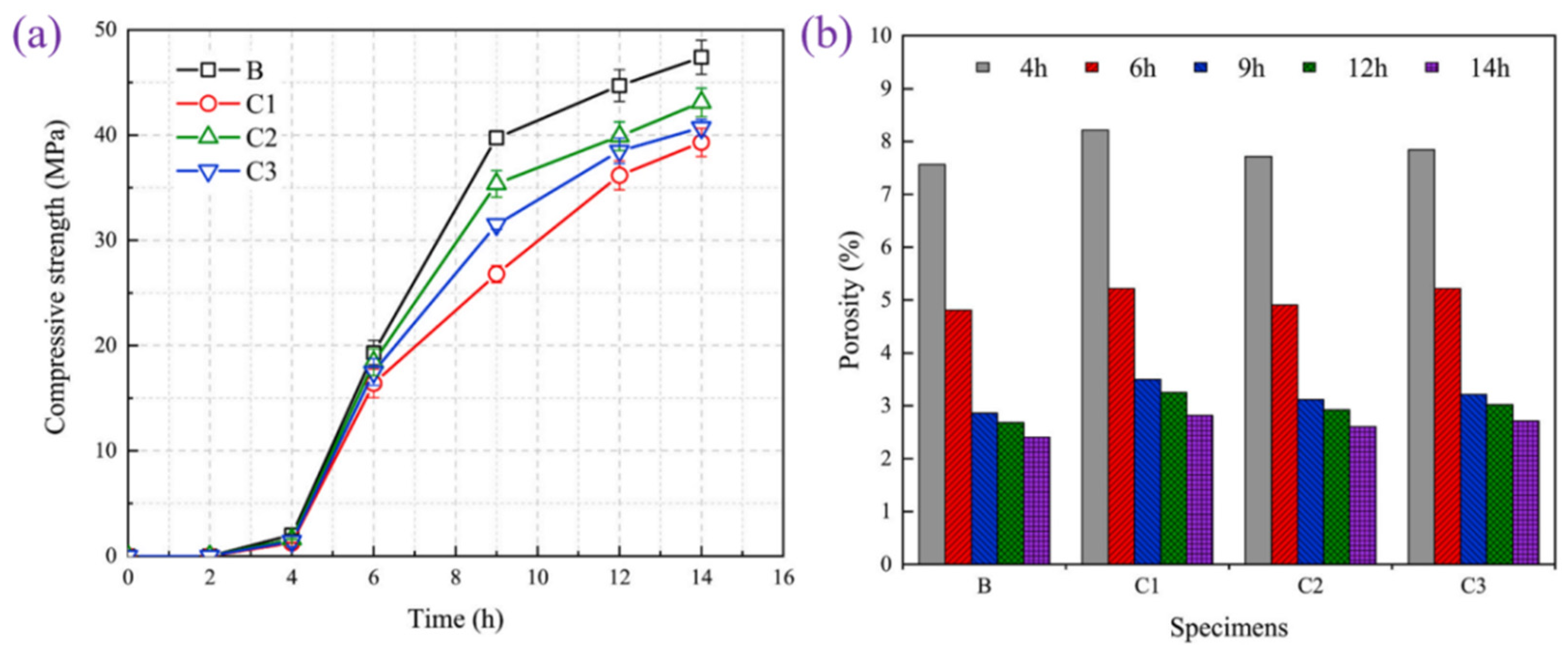

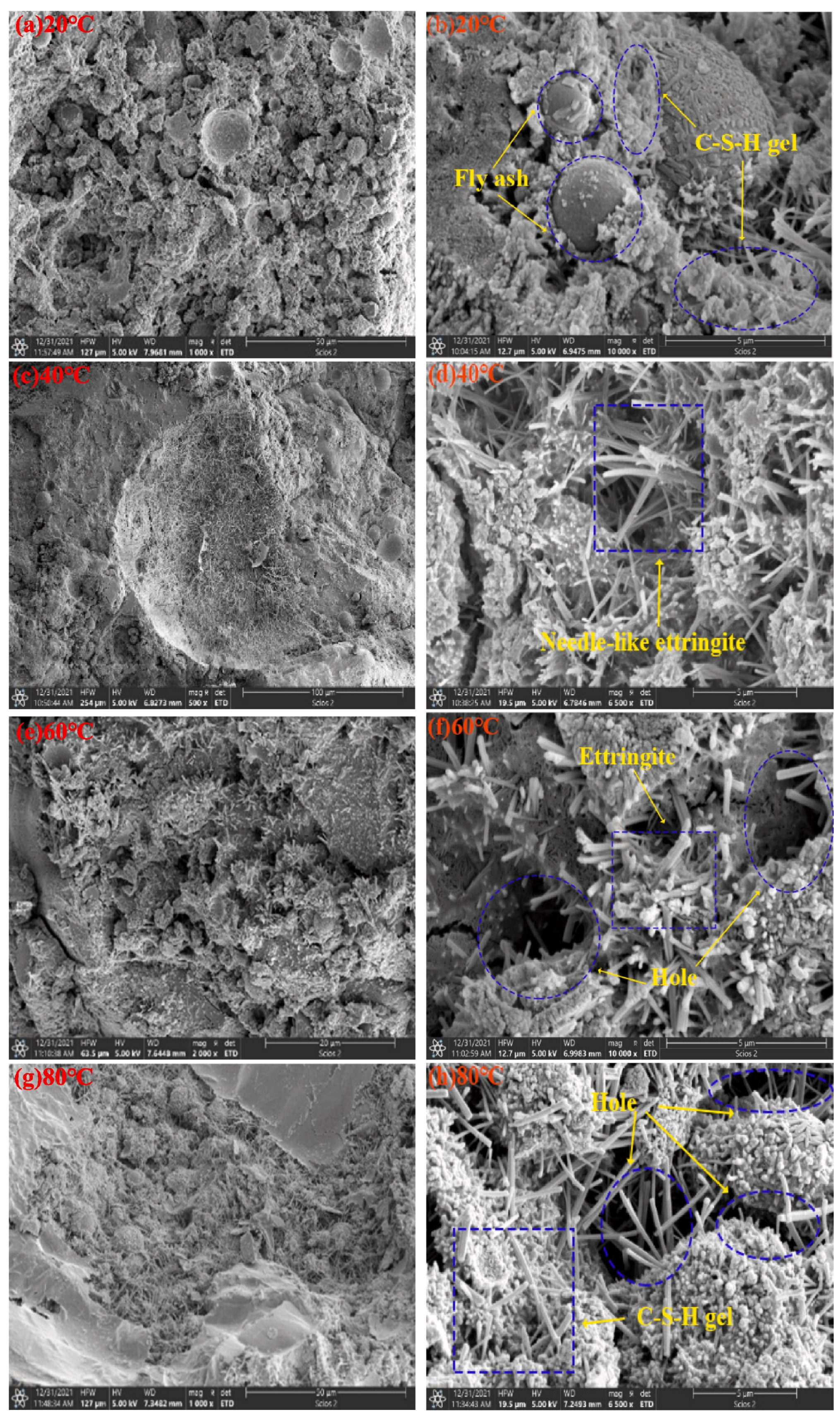
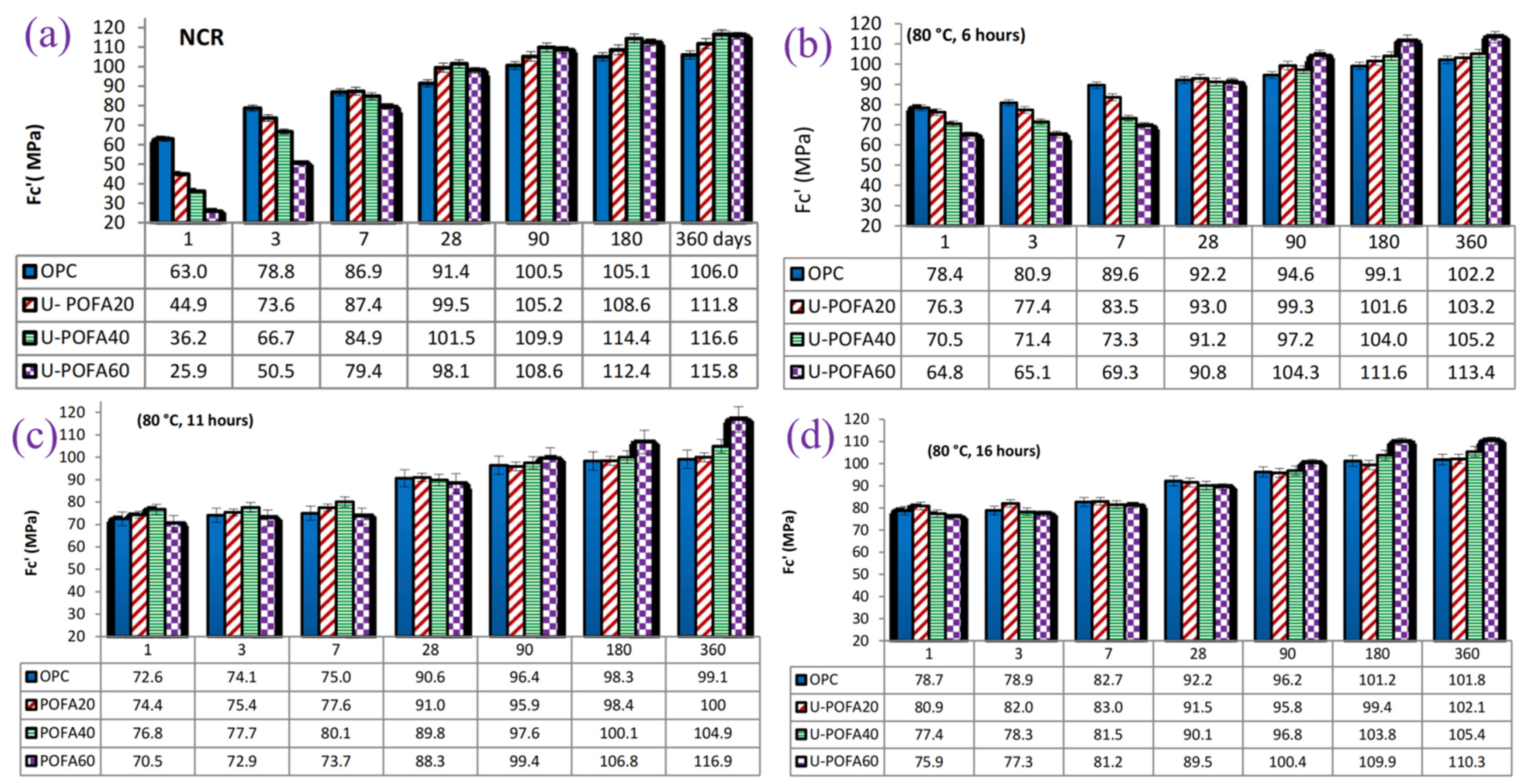
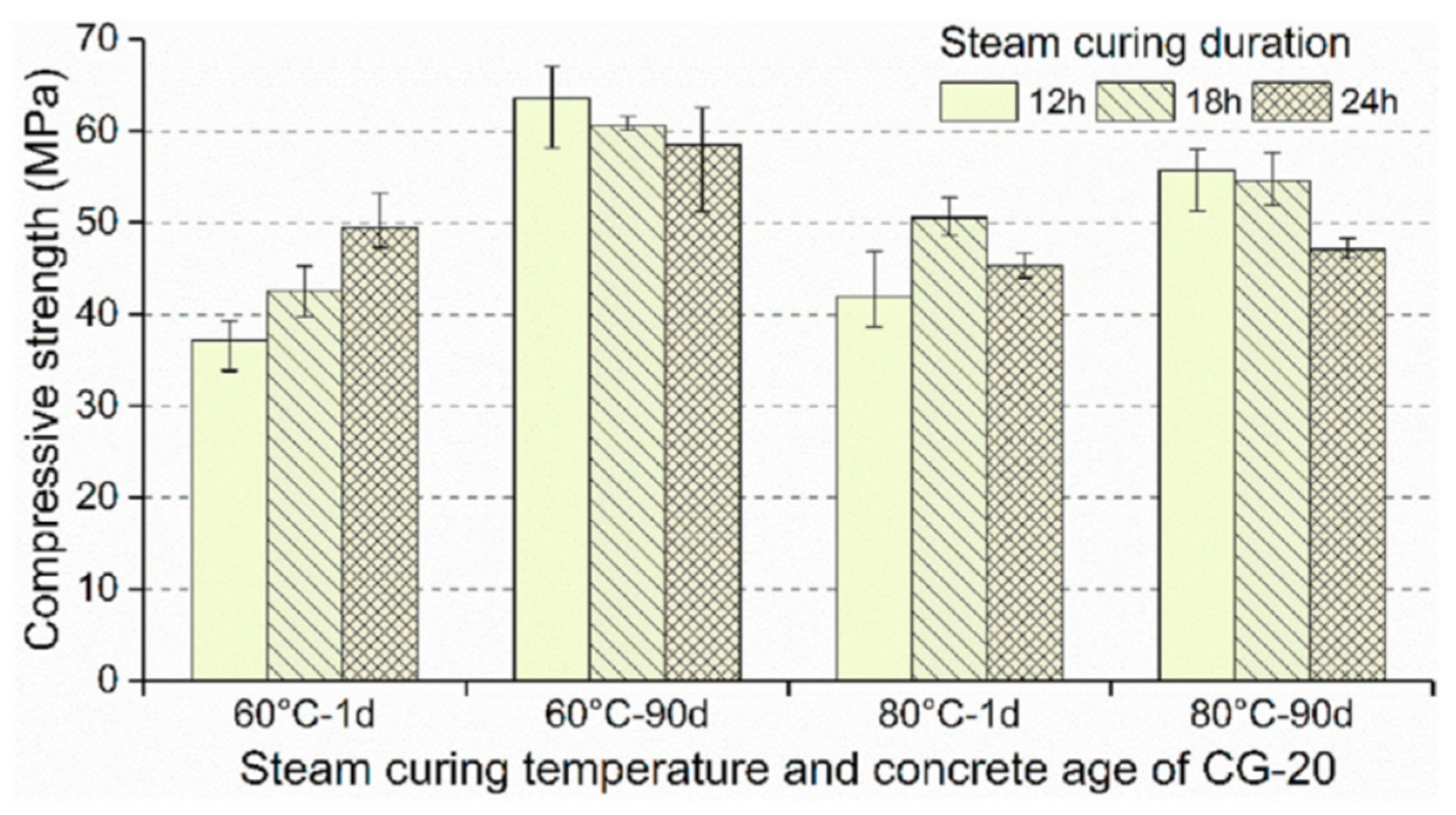
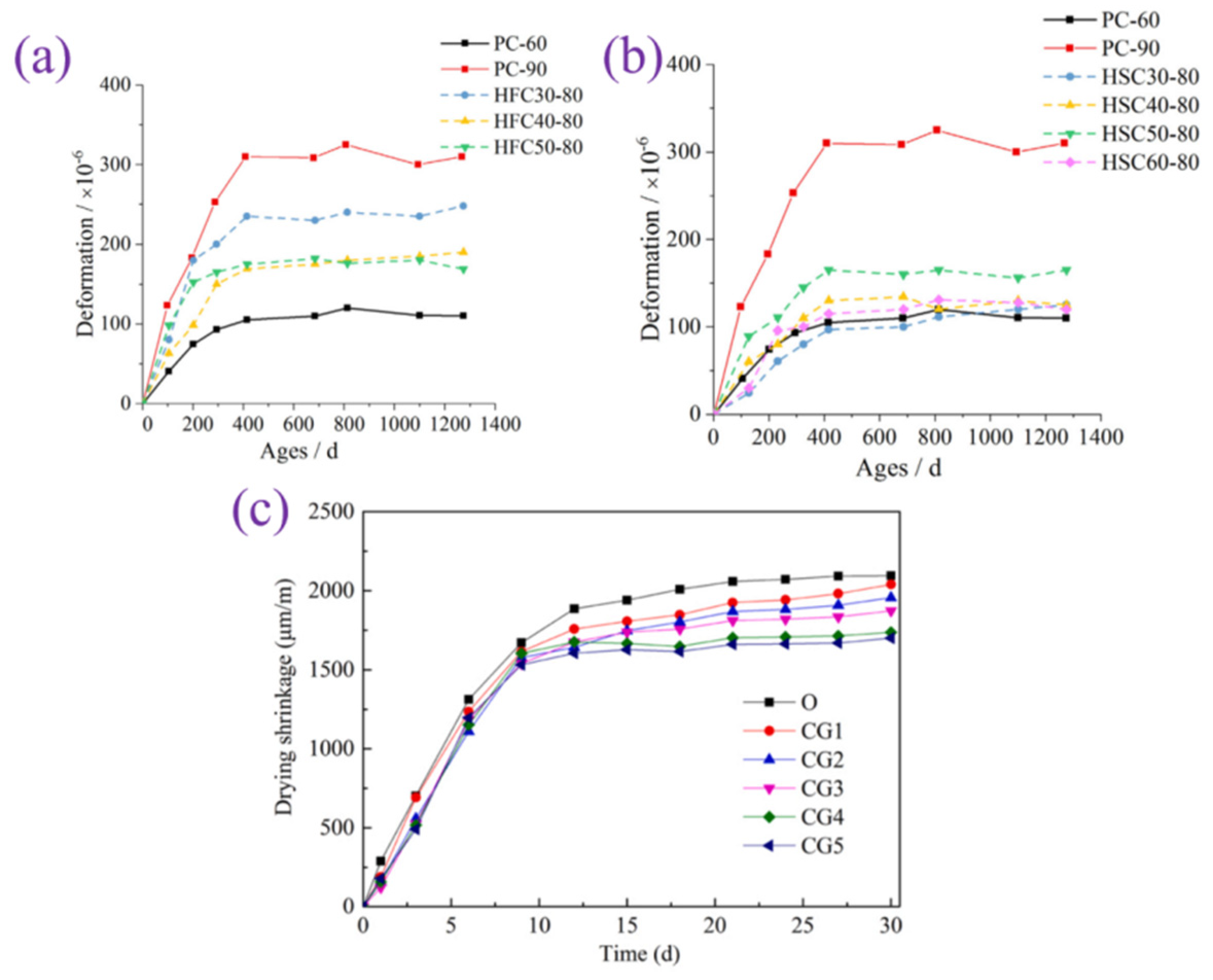

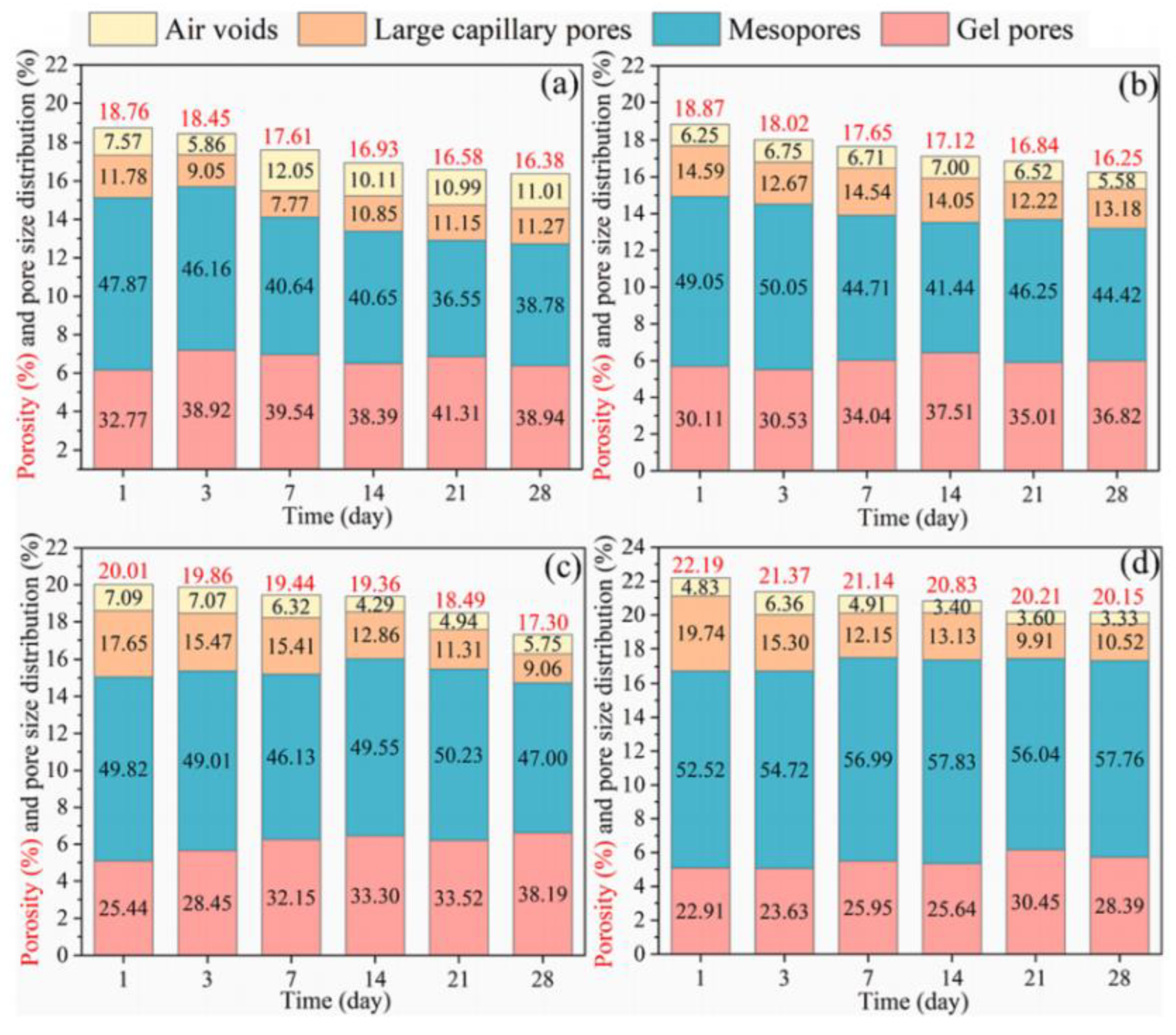
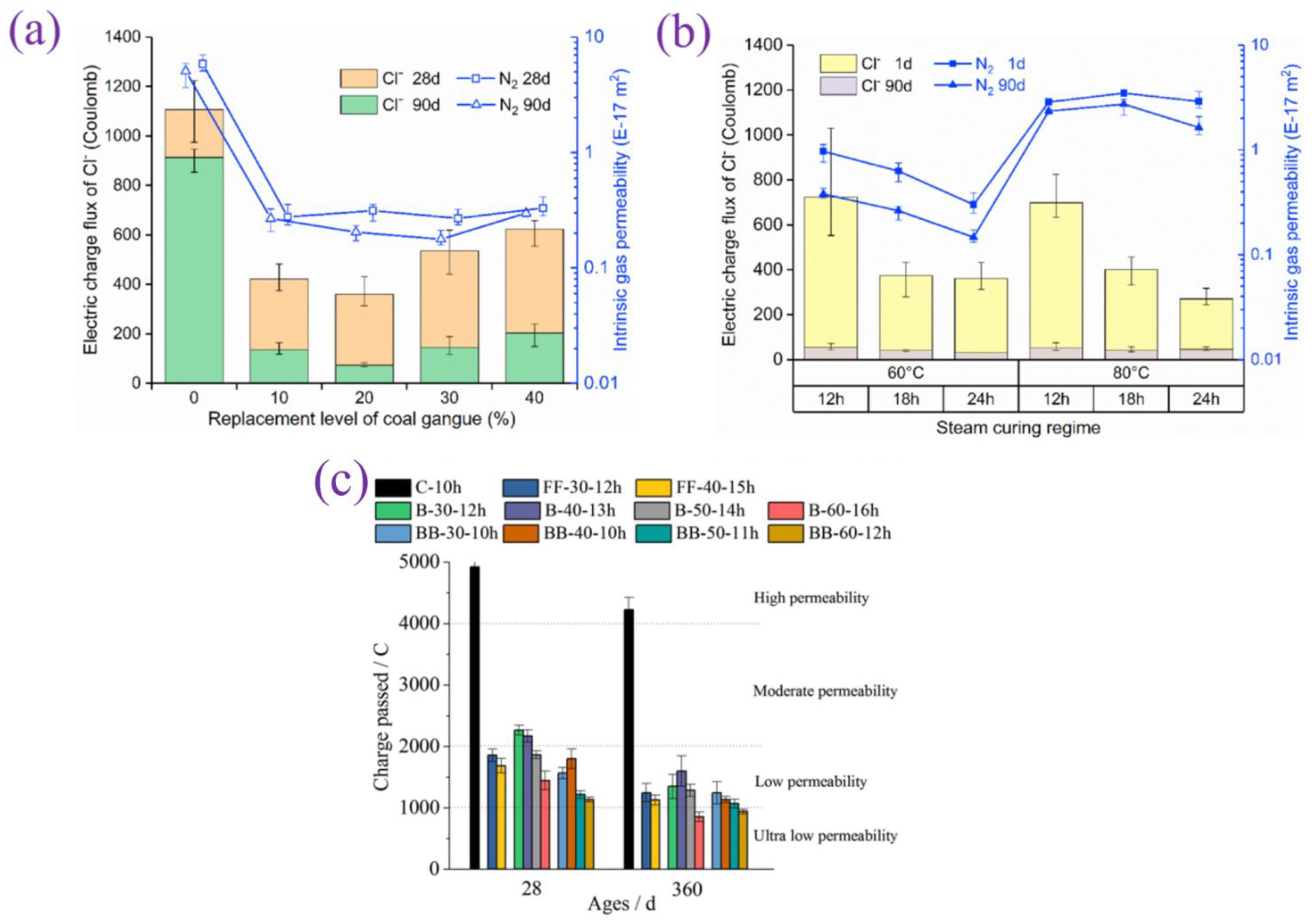
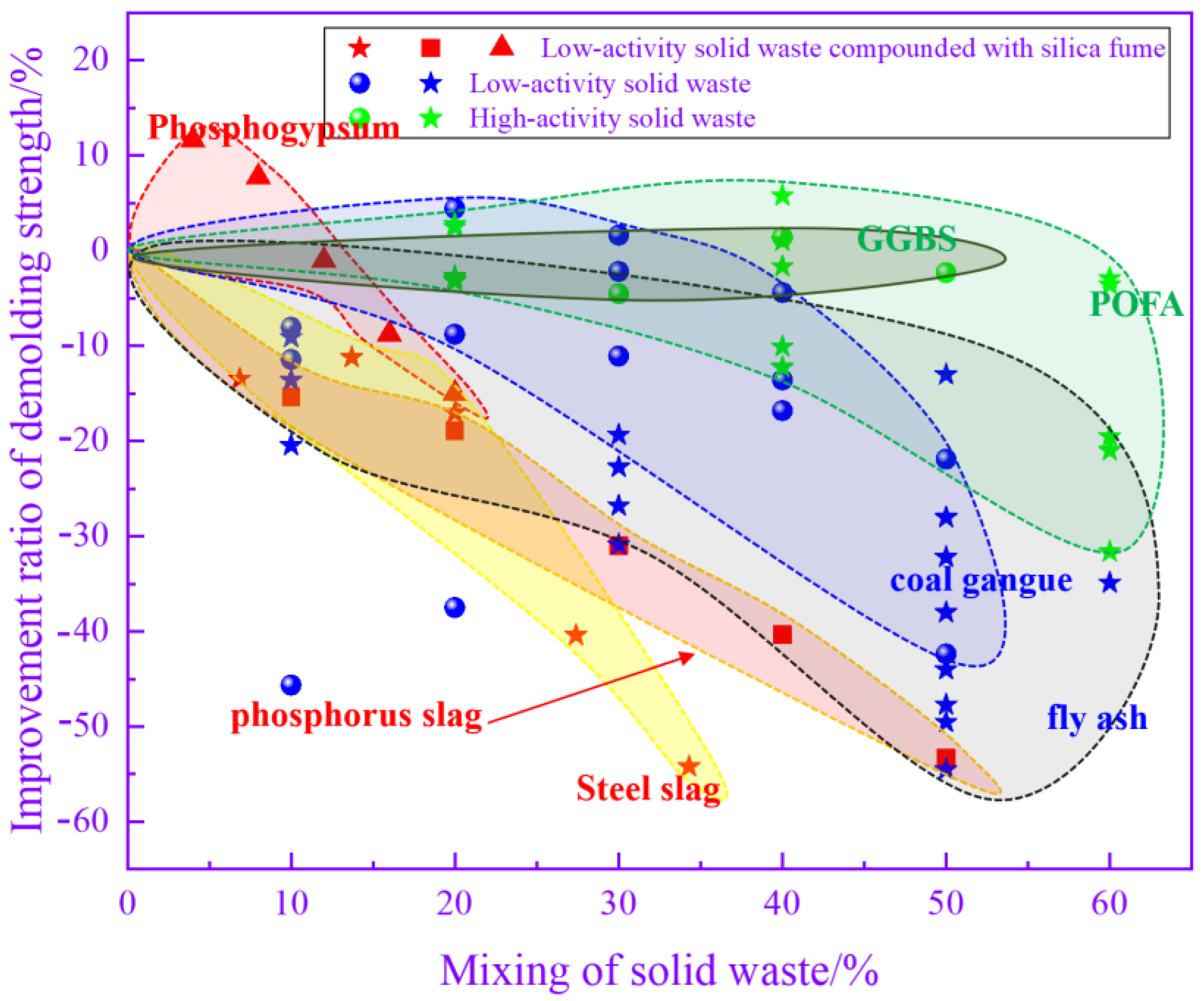
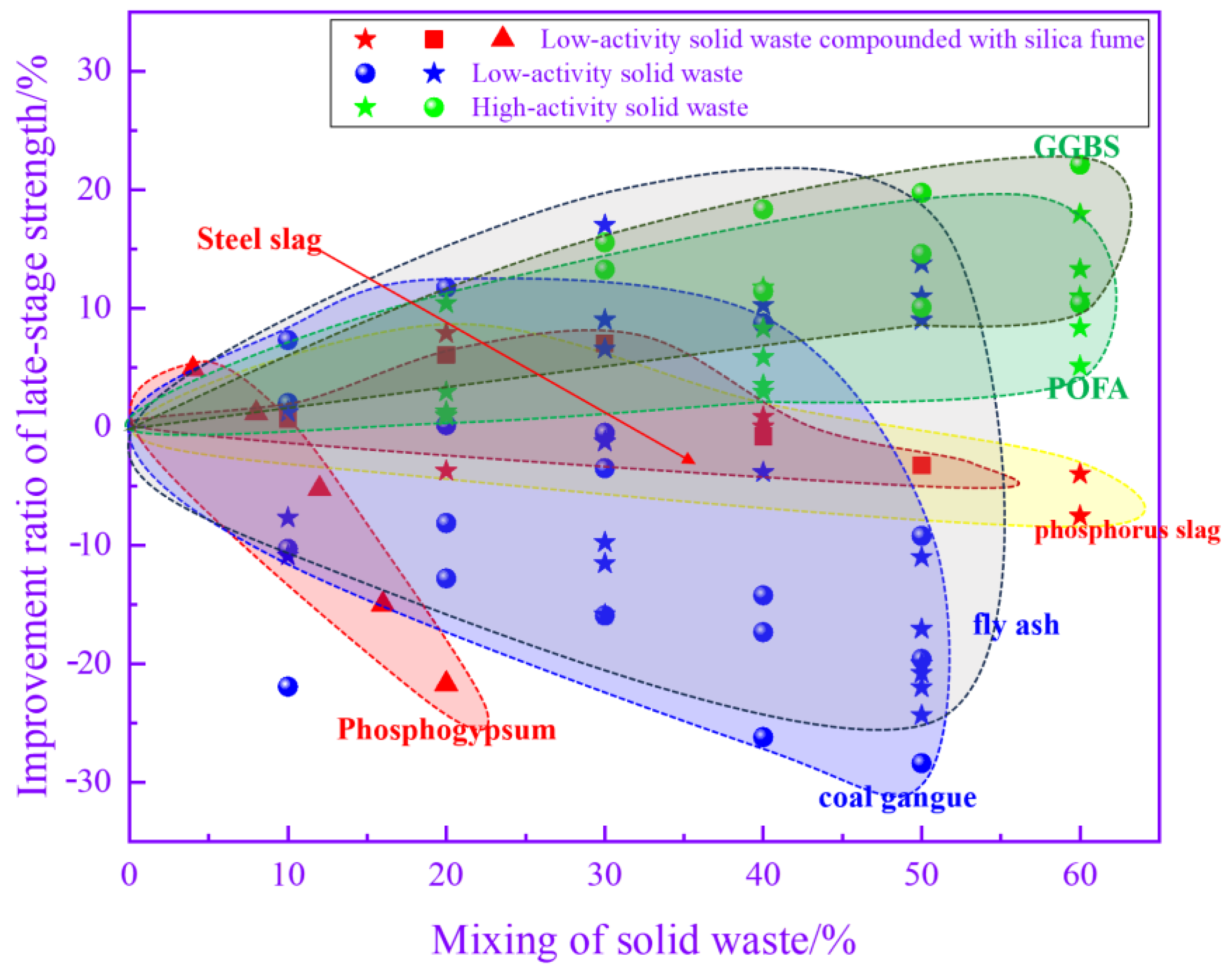
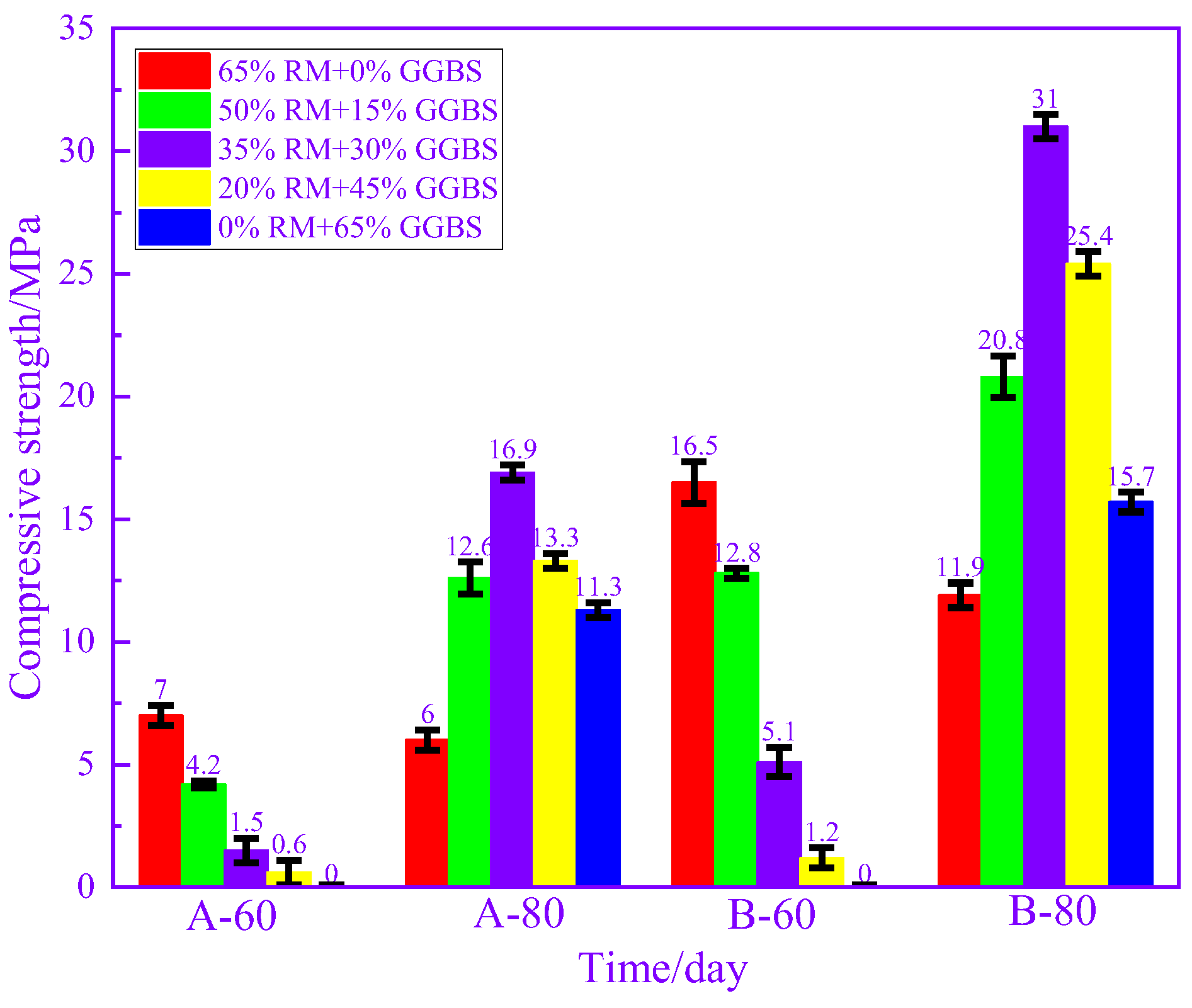
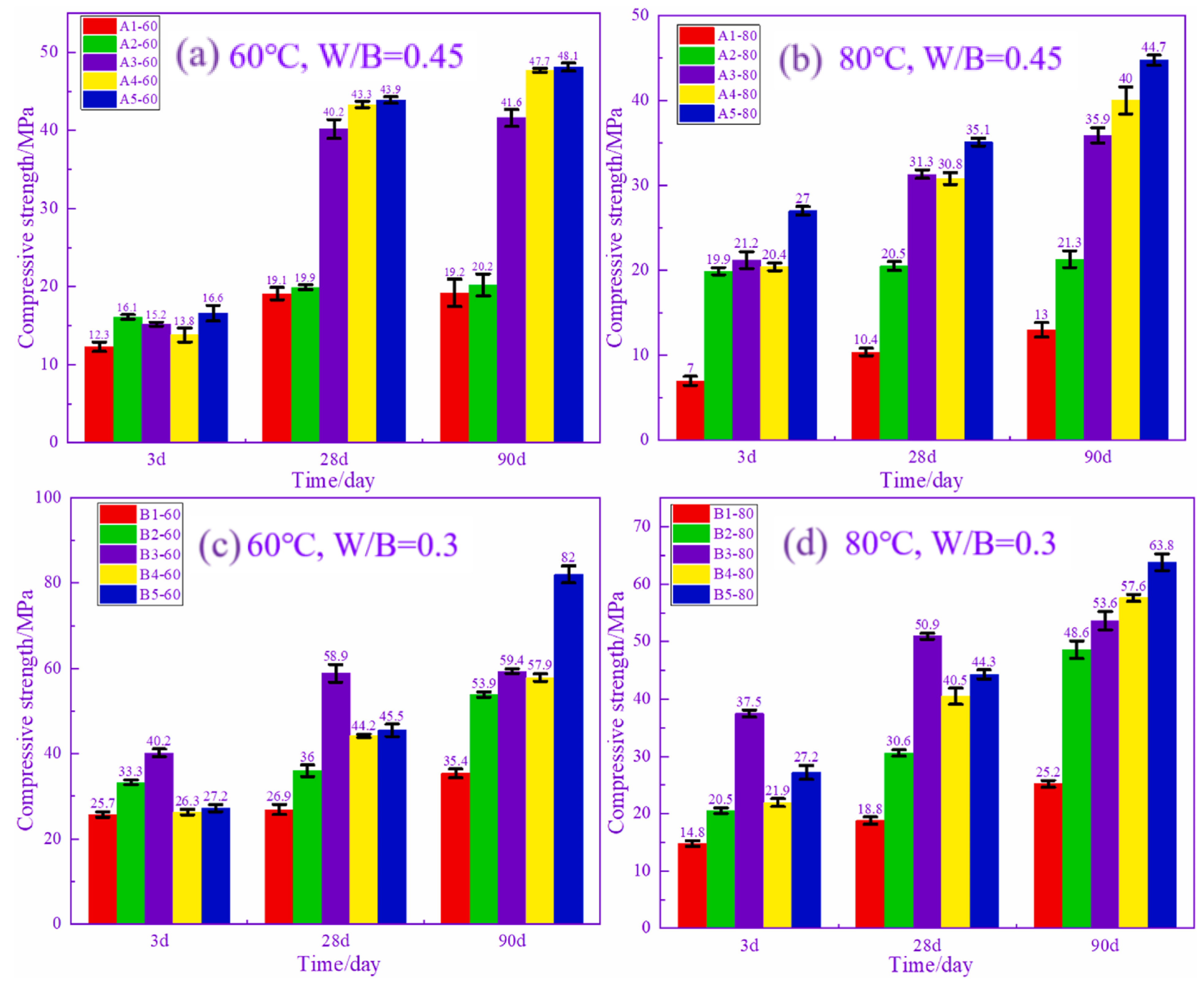
Disclaimer/Publisher’s Note: The statements, opinions and data contained in all publications are solely those of the individual author(s) and contributor(s) and not of MDPI and/or the editor(s). MDPI and/or the editor(s) disclaim responsibility for any injury to people or property resulting from any ideas, methods, instructions or products referred to in the content. |
© 2024 by the authors. Licensee MDPI, Basel, Switzerland. This article is an open access article distributed under the terms and conditions of the Creative Commons Attribution (CC BY) license (https://creativecommons.org/licenses/by/4.0/).
Share and Cite
Shao, Y.; Zhang, Z.; Liu, X.; Zhu, L.; Han, C.; Li, S.; Du, W. Comprehensive Utilization of Industry By-Products in Precast Concrete: A Critical Review from the Perspective of Physicochemical Characteristics of Solid Waste and Steam Curing Conditions. Materials 2024, 17, 4702. https://doi.org/10.3390/ma17194702
Shao Y, Zhang Z, Liu X, Zhu L, Han C, Li S, Du W. Comprehensive Utilization of Industry By-Products in Precast Concrete: A Critical Review from the Perspective of Physicochemical Characteristics of Solid Waste and Steam Curing Conditions. Materials. 2024; 17(19):4702. https://doi.org/10.3390/ma17194702
Chicago/Turabian StyleShao, Yang, Zengqi Zhang, Xiaoming Liu, Lilei Zhu, Chun Han, Siyi Li, and Weijie Du. 2024. "Comprehensive Utilization of Industry By-Products in Precast Concrete: A Critical Review from the Perspective of Physicochemical Characteristics of Solid Waste and Steam Curing Conditions" Materials 17, no. 19: 4702. https://doi.org/10.3390/ma17194702








